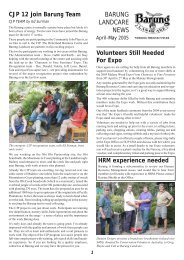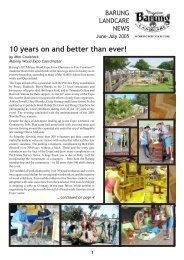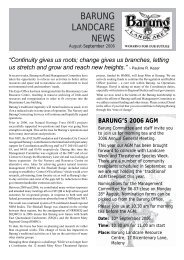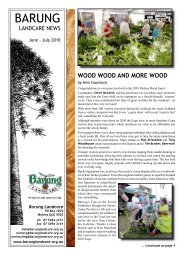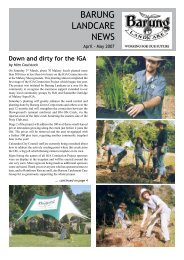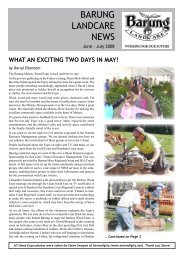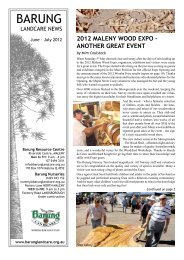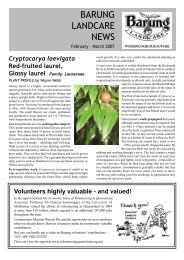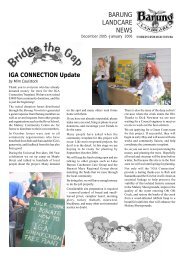Aug/Sep 2005 - Barung Landcare
Aug/Sep 2005 - Barung Landcare
Aug/Sep 2005 - Barung Landcare
Create successful ePaper yourself
Turn your PDF publications into a flip-book with our unique Google optimized e-Paper software.
A Ferny Understorey<br />
THE ORNAMENTAL GARDEN by Joan Dillon<br />
I was very impressed during a visit to NZ earlier this year by the<br />
many species of ferns carpeting the forest floors. Not for nothing<br />
is the fern a national symbol! I was also interested to note, while<br />
walking the trail below Lake Baroon, that the predominant<br />
understorey plants were ferns. I then noticed the developing understorey<br />
in a less visited area of my regenerating forest was, surprise,<br />
surprise, ferns! It’s not a bad idea to occasionally stop admiring<br />
the trees and check out the ground.<br />
Finding suitable understorey plants for rainforest gardens can be<br />
a challenge as many shrubby plants tend to get leggy in the shade.<br />
A protective cover for the soil is essential. Enter the fern.<br />
Ferns are many and varied and not all are delicate. They can be<br />
used for edging garden beds, binding the soil on banks, as feature<br />
plants or as ground covers, and the list goes on. The well-known<br />
ones in most native gardens would be the basket ferns, epiphytic<br />
staghorns and elkhorns, and probably treeferns. My little creek<br />
has a natural population of treeferns which are steadily multiplying<br />
now their habitat has been stabilised.<br />
The big epiphytes will grow a lot faster with a regular light spray<br />
of water but will still grow quite well if the aspect is correct.<br />
Check out the dominant direction for your rainfall. Any naturally<br />
growing plants in our area are on the south-east facing side of the<br />
host trees, along with a varied array of lichens.<br />
At the other end of the size scale, the common maidenhair<br />
Adiantum aethiopicum is exceptionally hardy in a dry shaded<br />
position, doesn’t mind being divided with a spade, and makes a<br />
delightful frothy edge to a shrubbery. It resents total shade so<br />
tends to remain as a sizeable edge plant. So long as the wiry<br />
rhizomes remain cool and protected under the mulch, water doesn’t<br />
seem to be an important issue. The rough maidenhair Adiantum<br />
hispidulum is a tough widespread fern which has attractive pink<br />
new fronds and does best in a semi-protected position. It’s often<br />
found as individual clumps on slopes or against old exposed tree<br />
roots. I’m trying it as a ground cover under the canopy of a large<br />
Homolanthus populifolius and don’t expect it to need any water<br />
once established. Unfortunately mistflower tends to favour the<br />
same habitat and will out-compete it, but once the mistflower has<br />
gone, this fern can become a single species carpet in selected<br />
areas. Doodia aspera, the prickly rasp fern, is another hardy fern<br />
with bright pink or red new fronds. It will grow in large colonies<br />
and will tolerate root competition and also more exposure.<br />
Another exceptionally hardy and larger species is binung Christella<br />
dentata which has a short creeping rhizome and grows into<br />
rounded spreading tussocks. This one is naturally colonising our<br />
steep dry slopes, mostly in at least light shade. It also grows on<br />
the edge of a road gutter so additional plants have been added to<br />
the recently cleared road embankment. It should establish well<br />
during the cooler months. Its final purpose will be to hold the<br />
bank, form an attractive visual edge for the rainforest trees planted<br />
on top of the bank, and eventually spread under them. Blechnum<br />
nudum is another tall fern which favours moist sheltered situations.<br />
A narrow edging of what is possibly giant brake, a Pteris, has<br />
developed along the top of a gully after a 2-3 metre high lantana<br />
wall was removed. The relatively tall clumps do not appear to be<br />
spreading back among the trees where native forest grass dominates<br />
the understorey but are definitely out-competing the annual<br />
weeds along the edge. It will need watching in case it becomes<br />
too vigorous for the ornamental garden, but I just love it when<br />
nature does my landscaping for me!<br />
CJP ‘Mark I’ Rap Up<br />
Ed Surman<br />
The first Community Jobs Plan project, partnered by the State<br />
Government’s Department of Employment and Training, the<br />
Hinterland Business Centre and <strong>Barung</strong> <strong>Landcare</strong>, has come to<br />
an end … and what a precedence did it set!<br />
Throughout the seventeen-week project, there were many positive<br />
achievements.<br />
The environmental outcomes are the easiest to measure and<br />
quantify. A massive 27 m 3 of weed propagules (mostly Madeira<br />
vine tubers) were removed from sites along the Obi. 1990 native<br />
plants were planted and cared for by the dedicated crew of willing<br />
workers, thousands of plants tubed up or potted on in the nursery,<br />
and weeding and general nursery work was carried out. The reveg<br />
team brush-cut, weeded, and sprayed thousands of square metres<br />
of revegetation sites.<br />
Community outcomes are noteworthy. The CJP team, along with<br />
the army of volunteers, provided the backbone for the huge task<br />
that is the Chainsaw to Fine Furniture Expo. CJP participants not<br />
only worked for weeks to set up and pull down this nationally<br />
renowned event, but also came in over the weekend and<br />
volunteered at the <strong>Barung</strong> tent, imparting the wealth of<br />
environmental and land management practices they had learnt<br />
throughout their project. In fact, one of the aspects of this team<br />
that made working with them so rewarding was listening to them<br />
engage the public, informing passers-by about what and why they<br />
were doing what they were doing. The whole team acted as<br />
ambassadors for landcare, raising awareness of the issues affecting<br />
our natural heritage. The team helped a range of community<br />
organisations such as the Bellthorpe Progress Association, the<br />
Maleny & Districts RSL, Mooloolah Waterwatch, and the Genesis<br />
land foundation.<br />
There were also a lot of personal benefits for all involved.<br />
Friendships were formed, the team worked together very well,<br />
consistently displaying the ability to accept and value each other’s<br />
differences. We learnt about our strengths and weakness, we<br />
inspired and encouraged each other. The attitude displayed by all<br />
participants made work a fun and enjoyable experience. One of<br />
the benchmarks for success for CJP projects is the employment<br />
outcomes. We are happy to report over half the team has gained<br />
employment or is going on to further studies. Well done team!<br />
<strong>Barung</strong> <strong>Landcare</strong> would like to thank the Department of<br />
Employment and Training, the Hinterland Business Centre and<br />
all of the community groups that provided us with meaningful<br />
work. And last but not least, thank you to the team that has created<br />
a lasting impression: Dee Dent, Valerie Martin, Daniel Wicker,<br />
Leon Shingles, Zoë Jung, Tara, Donald Greenfield, Jeff Scott,<br />
Keith Hickman, Gaby Luft and Steve McLeish.<br />
The State of the Region ...<br />
… continued from page 16<br />
Catchments. Our Regional Investment Strategies (RIS) will remain<br />
distinct till the end of <strong>2005</strong>, and a new combined RIS will be<br />
developed for next year.<br />
Mooloolah Landslip – An extensive landslip in the upper<br />
Mooloolah catchment is now being addressed by Mooloolah<br />
Waterwatch & <strong>Landcare</strong>. Through an NLP grant the group is<br />
coordinating a stakeholder response and monitoring the stream<br />
during rain events.<br />
8



